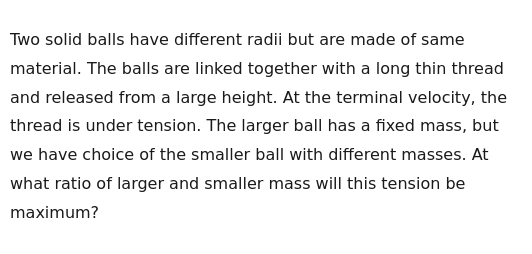Question
Question: Two solid balls have different radii but are made of same material. The balls are linked together wi...
Two solid balls have different radii but are made of same material. The balls are linked together with a long thin thread and released from a large height. At the terminal velocity, the thread is under tension. The larger ball has a fixed mass, but we have choice of the smaller ball with different masses. At what ratio of larger and smaller mass will this tension be maximum?

The tension is maximum when mSmL≈4.74.
Solution
We begin by noting that for a sphere moving through air the drag force is
FD=21CDρAv2,with cross–sectional area A=πR2 and for a solid sphere of density ρball the mass is
m=34πR3ρball.Thus if we eliminate R we obtain
R∝m1/3⟹A∝m2/3.So we write the drag force in the form
FD=αm2/3v2,where α is a constant (including 21CDρ and numerical factors).
Now we have two balls—the larger one has a fixed mass mL and the smaller one a mass mS. When they are linked by a thread and falling at their common terminal speed v (steady state) each ball obeys a force‐balance. For the larger ball (taking downward as positive, and noting that the drag is upward and the thread pulls upward) we have
mLg−FDL−T=0⟹T=mLg−αmL2/3v2,while for the smaller ball (here the thread pulls downward on it) we obtain
mSg−FDS+T=0⟹T=αmS2/3v2−mSg.Equate the two expressions for T:
mLg−αmL2/3v2=αmS2/3v2−mSg.Solve for v2:
α(mS2/3+mL2/3)v2=g(mL+mS),so that
v2=α(mS2/3+mL2/3)g(mL+mS).Substitute back (say, in the expression for the small ball) to get
T=αmS2/3v2−mSg=mS2/3+mL2/3gmS2/3(mL+mS)−mSg.It is convenient to introduce the mass–ratio
r=mSmL(with r>1),so that mL=rmS. Notice also that
mL2/3=(rmS)2/3=r2/3mS2/3.Then the numerator becomes
mS2/3(rmS+mS)=mS5/3(r+1),and the denominator is
mS2/3(1+r2/3).Thus
T=mS2/3(1+r2/3)gmS5/3(r+1)−mSg=1+r2/3gmS(r+1)−mSg.So we may write
T=gmS[1+r2/3r+1−1]=1+r2/3gmS[(r+1)−(1+r2/3)]=1+r2/3gmS(r−r2/3).It is now clear that for a fixed larger mass mL the smaller mass mS is a free parameter. Writing
mS=rmL,the tension becomes
T=rgmL⋅1+r2/3r−r2/3=gmL1+r2/3r1/3−1r−1/3.Let
x=r1/3⟹r=x3,so that
T=gmLx(1+x2)x−1.Since g and mL are constant, maximizing the tension is equivalent to maximizing
f(x)=x(1+x2)x−1for x>1.
Differentiate f(x):
f′(x)=dxd[x+x3x−1].Using the quotient rule (with u=x−1 and v=x+x3; note u′=1 and v′=1+3x2):
f′(x)=v2u′v−uv′=(x+x3)2[1⋅(x+x3)]−[(x−1)(1+3x2)].Expanding,
x+x3−(x−1)(1+3x2)=x+x3−(x+3x3−1−3x2)=x+x3−x−3x3+1+3x2=1−2x3+3x2.Setting the numerator equal to zero gives the equation
1−2x3+3x2=0⟹2x3−3x2−1=0.This cubic in x has a unique real solution for x>1. A numerical solution shows:
- At x=1: 2−3−1=−2 (negative),
- At x=1.7: 2(4.913)−3(2.89)−1≈9.826−8.67−1≈0.156 (close to 0).
Refining the estimate we find approximately
x≈1.68.Since r=x3, the optimum mass–ratio is
r≈(1.68)3≈4.74.Thus, the thread tension is maximized when the mass–ratio is
mSmL≈4.74.In summary: Write the drag force on each ball as proportional to m2/3v2, set up force–balances for the large and small balls, equate the tensions, substitute r=mL/mS (with mS=mL/r) and express the tension in terms of r. Then by substituting x=r1/3 the tension becomes proportional to x(1+x2)x−1. Differentiating with respect to x and setting the derivative to zero gives x≈1.68 so that r≈(1.68)3≈4.74.
